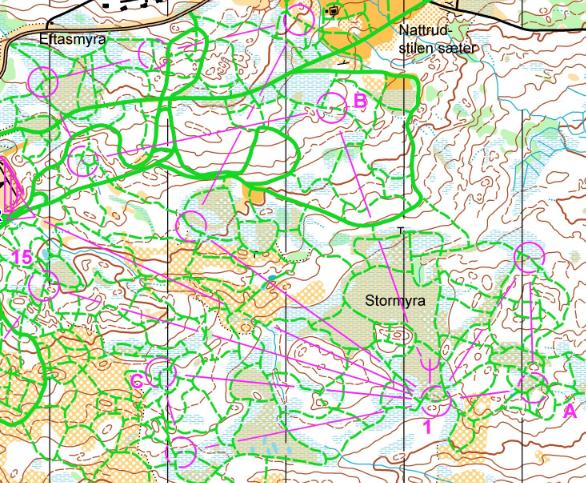
Do we currently have a way to make mass start interesting for spectators and TV viewers? Watching the mass start in the European Championships (EOC) in Ski-orienteering on Saturday got me thinking about the topic, as it is well known that there is ongoing work in the “WOC in the future” work group in order to determine if mass start will be on the World Championships (WOC) program for foot-orienteering in the future.
The basis for working on including mass start in the WOC of the future can be found in the following formulation from the “WOC in the future” report presented by the IOF Council to the 2010 IOF General Assembly (direct quotes from the report):
Individual start competitions need to be complemented with formats such as chase and mass starts where first-to-finish is the winner. Such development will introduce new challenges to a traditional concept and address the ambition to further raise the spectator and media values of WOC. […] Events need to become even more attractive to follow, both live at the arena and through TV and web-cast media. To achieve this, events need to be made easier to understand and appreciated and more exciting to watch.
How would you make a mass start event in orienteering interesting to watch for spectators in the arena or for a TV audience?
Keep this in mind while reading the rest of this comment. In addition to the Council’s report, the General Assembly agenda also included another item relating to the future WOC programme, namely Norway’s proposal to introduce a mass start – and this proposal was decided for. Apologies for the long article – please skip directly to the discussion if you only want my conclusions – or even all the way down to the poll at the bottom of the page.
Note! These are my personal thoughts about the matter – and I am very much open for input and discussion. I would be grateful for any input – please come up with a good spreading principle for mass start and enlighten me! How would you make a mass start event in orienteering interesting to watch for spectators in the arena or for a TV audience? Note also that one option as to how to introduce a mass start is through a knock-out sprint which is not further discussed in this comment.
Mass start already on the WOC program
In Ski-orienteering, mass start has already been part of the regular WOC and EOC program for some years. Thus it was with great interest I sat down on Saturday to watch the live coverage from the EOC ski-o mass start. Maybe there is something to learn from the experiences in ski-orienteering? How does the spreading work? Is it interesting to watch? As I don’t know the sport as well as foot-orienteering, I thought I’d see it a bit more from the outside.
EOC ski-o: Great live coverage
The live coverage from the EOC was great for a ski-orienteering event – GPS-tracking, video feed, live results and LiveBlog. According to the statistics there were between 500 and 700 unique viewers on the video feed each of Saturday and Sunday – and around 1400 TV hours watched in total. The video feed did only have cameras at the finish to go along with GPS tracking and results boards + speaker sound, but although more cameras would have made the broadcast better, I don’t think it would have changed my overall impressions regarding the mass start concept chosen.
Women: Nothing for 30 minutes
… watched for the first 30 minutes of the 40 minute race without knowing anything about the outcome
The mass start event at the EOC ski-o was a middle distance event (at WOC ski-o the mass start is at the long distance event). For the women that means a winning time of around 40 minutes. The course layout was as follows (see GPS-tracking here – see also map showing the three-winged butterfly above):
- A long leg to the first control which was the same for all competitors (around 4 minutes skiing time)
- Three butterfly wings with different length from this first control – length of the wings were around 4, 6 and 16 minutes.
- Around 10 minutes with common controls in the end
I tried to follow the GPS-tracking closely in order to understand who was in the lead, but for me it was impossible to find out the standings until the end of the three-winged butterfly. The commentator didn’t even try to figure out who was in the lead either as far as I could hear, so we both (along with all other spectators) watched for the first 30 minutes of the 40 minute race without knowing anything about the outcome. Then, after 30 minutes of “mystery”, 2 competitors – Tatyana Kozlova and Marthe Renaas – emerged together with a lead of about 40 seconds – ready for 4 common controls towards the finish. Luckily for the competition, there was some excitement around the second last control as Kozlova made a mistake. Finally Renaas took a relatively clear victory.
Men: Better – but still not what we are aiming for?
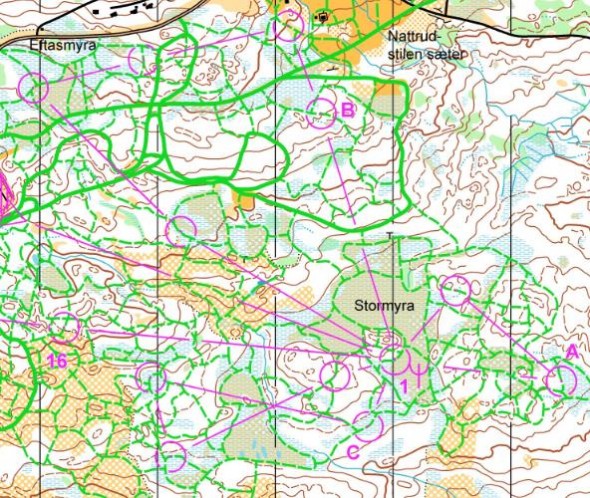
The men’s course was a bit longer (see GPS tracking part 1 and part 2) – with a winning time of around 48 minutes. A similar course layout to the women in the start, but then an extra loop in the end:
- A long leg to the first control which was the same for all competitors (around 3 minutes skiing time)
- Three butterfly wings with different length from this first control – length of the wings were around 4, 5 and 12 minutes (see map with butterfly above – approximately the same as for the women)
- Around 7 minutes with common controls to a map exchange/spectator control
- Around 3 minutes with common controls to a new butterfly, this time with two wings
- Around 8 minutes for the two butterfly wings (see map below)
- Another 6 minutes with common controls to the finish
Unfortunately I left the ski-orienteering for another TV-channel (cross country skiing)
For the men there was thus around 24 minutes of “mystery time” in which it was impossible to know who was in the lead. Then Staffan Tunis emerged first after the three-winged butterfly with Erik Rost not far behind. Unfortunately I left the ski-orienteering for another TV-channel (cross country skiing) during the final parts of this “mystery time” as it was quite frustrating to watch without knowing anything. That is a pity, because by watching the GPS-tracking and the LiveBlog afterwards I saw that the rest had indeed been quite exciting. Rost chased Tunis towards the next butterfly – taking different route choices – and coming a little bit closer. Then they (fortunately) had the same forking in the butterfly, and Rost finally managed to catch up with Tunis towards the end of the race. In the end Rost was a few seconds faster, beating Tunis in the very last part.
– This was really exciting, was the comment from Anatolijs following the LiveBlog just after Tunis had taken the gold medal – so there is no doubt mass start has potential.
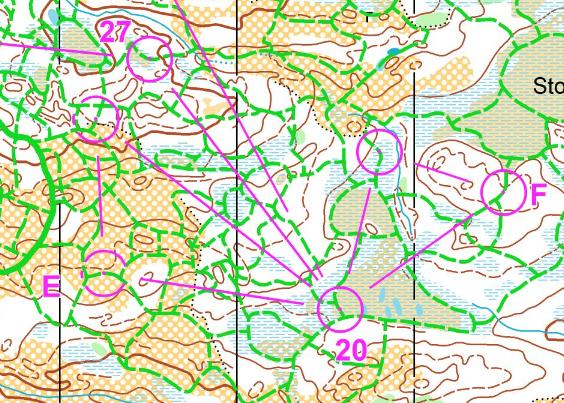
Good TV broadcast possible on this very day?
we get into the broadcast when most of the big decisions are already made
Looking back at the GPS tracking now, I see that if this would have been a full TV broadcast with a good job done by a TV director, it would actually have been possible to make an “acceptable” 45 minute broadcast out of it:
- 11:20: Women start
- 11:45: TV broadcast starts with showing the women’s start + some interviews
- 11:50: TV broadcast goes in live from when the women leave the butterfly. TV broadcast follows the last 10 minutes of the womens race through GPS-tracking and as many cameras as possible. Maybe even possible with some scooter camera in ski-orienteering?
- 12:00: First women in the finish. 5 minutes with interviews.
- 12:05: The first men leave the three-winged butterfly. TV broadcast follows the rest of the mens race with GPS-tracking and as many cameras as possible. Of the remaining 23 minutes of the race about 15 minutes are common and 8 minutes are gaffled (ad time?) – but not really that much “mystery time” as there are only two loops on the butterfly.
- 12:28: First men in the finish. A few minutes with interviews.
- 12:30: End of broadcast – could also stay for a few more minutes.
I think it could actually have been made a quite good TV broadcast with the proper resources ( = many cameras = high cost) available. However, my problem with this TV broadcast is that we don’t see the competitors in the parts of the course were a lot of the decisions are bound to be made. Both in the men’s and the women’s course we get into the broadcast when most of the big decisions are already made.
Is there any good spreading principle available for mass start today?
The period of “mystery time” kills all excitement
Of course, these courses were probably not geared towards making this a top experience for the spectators/TV audience – but rather towards making a fair competition for the competitors(?) – so we shouldn’t judge this type of spreading principle in a mass start race based on this race alone. However, I have watched quite a few events with GPS-tracking and mass start with spreading systems which are based on the similar principles as the EOC ski-o middle, and the conclusion has always been the same: The period of “mystery time” kills all excitement – and this period is usually from 15 minutes and upwards. The same goes for other races with mass start – I still can’t remember having seen one with a spreading principle which kept me in front of the screen for the “spreading part” of the broadcast.
I choose to divide the spreading principles into these categories (based on the extensive report and separating methods in orienteering and what I have seen):
- One or two two-winged butterflies. In these cases, it is possible to follow the standings quite closely as long as the butterflies are not too long – one can also have an idea about the standings while the runners are in the butterflies. However, it doesn’t work very well for spreading principle in a mass start.
- Three winged butterfly like EOC ski-o middle. Worse than two-winged butterfly from a spectator point of view, as there is quite a long period of “mystery time”. It works better as a spreading method, though.
- Variants of phi-loops. Based on the length of the phi-loop, it may to some degree work from a spectator point of view – however I still have not seen an example of it working perfectly. At the Norwegian Champs night-o which I watched live GPS tracking from, I had no idea about the standings for most of the race – thus a fiasco from a spectators point of view (not sure if it should be categorized as phi-loop or loops though). However it looked like it was a quite good spreading principle seen from the runners point of view(?). At the WOC in Ukraine the phi-loops made it difficult to know the exact standing due to the phi-loops (this was an individual race, though). Phi-loops have probably the best possibilities of the methods used today, but it is very tricky to make these with close enough lengths to fulfill the requirements.
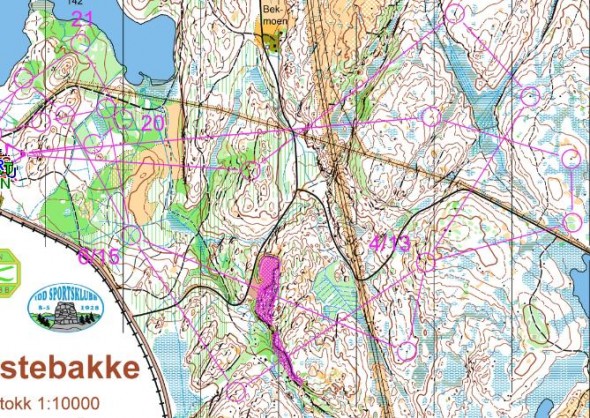
- Variants of forked/intervened loops with a final common loop with no spreading method or a butterfly. Used in most events with mass start – also in e.g. Blodslitet and quite a few Swedish events. Usually used in long or ultralong races with a relatively long “mystery time” at the start of the race through either two or three loops. Works quite OK from the runners point of view, but for TV you would have to start the broadcast after the loops (thus again loosing the part of the race where probably some of the big decisions are made).
- Some kind of “take these controls in any arbitrary order” (score-o) in part of the course – typically the first part of the course in the implementations I have seen. This has not been used in many elite events as far as I know, and in the implementations I have seen it doesn’t work well either for the runners nor for spectators(?).
- No spreading method at all. In this case, there is excitement if runners take different route choices on long legs.
Based on this list, you can see that I have yet to see a mass start with a spreading principle which (1) gives some kind of “fair” spreading and (2) at the same time makes it possible for the spectators to clearly follow the actual standings in large enough portions of the race. In addition, there is the problem with the number of cameras which probably will have to be higher in a mass start than in an individual race.
Discussion
A decision to put mass start on the WOC program must in my opinion be accompanied by a decision on a preferred spreading method
So, what is my conclusion? And why am I writing this (too long) comment? My main conclusion is that before a decision is made to include a mass start event in the World Championships program, one has to make sure that one has a spreading system which works for both TV and for the competitors. Putting mass start on the WOC program and “hoping” that the issue with an appropriate spreading system will be solved before 2014 would in my opinion be a big mistake – it could lead to a race like we saw in EOC ski-o middle on Saturday. A decision to put mass start on the WOC program must in my opinion be accompanied by a decision on a preferred spreading method. This “mass start concept” must be fully defined as a TV concept – including spreading method. And I also think such a concept must be tested in competitions with elite start field and TV coverage before such a choice is made.
Now, you can of course say that you are happy with the concept used on EOC ski-o middle. As I wrote, I think it would have been possible to make an OK 45 minute TV broadcast out of it. Or alternatively you can say that any of the other existing spreading principles which exist today are perfect for orienteering with mass start on TV.
However, then that kind of spreading concept shall be the basis of the decision to include mass start on the WOC program – and not the “hope” that some better method is developed before 2014. That’s my point!
PS! You can also say – which I am sure many will – that today’s WOC program is fine and you don’t want any changes. My comment is, however, written on the basis that IOF (and implicitly also the majority of the member countries) has decided that there will be change – my focus here is on not making the wrong changes.
Some random thoughts after 1 AM
Requirements for spreading are not that severe for chasing start
To finish of this comment – some random thoughts related to the topic:
- I see chasing start as a different thing. Requirements for spreading are not that severe for chasing start depending on how long the prologue for the chasing start is, and e.g. at the Nordic Orienteering Tour last year it was shown that a chasing start can work quite well. Although the original decision in Trondheim was to work on introducing a mass start race in the WOC program (as far as I have understood), a chasing start might seem just as probable?
- Relays are very much a different thing. Last Sunday there were relays in the EOC Ski-o, and these were very exciting races. I watched the last leg for men and for women – both with GPS-tracking – and they were both very exciting. No way I considered changing over to the cross country skiing broadcast on the other channel then. A lot of different route choices were made by the top teams, and there were changes in the top positions in the final parts of the race. The main reason for this difference is as far as I can see that the competitors never know if their next control is the same as their rivals, thus a competitor must alway trust his own judgement instead of following (due to not knowing the gaffling relative to the previous legs of the relay). This goes for all parts of the course, not only an isolated part of the course – and this is a very different situation from all the spreading principles discussed above. Now if it would be possible to introduce this in an individual mass start race… (A small PS! A problem with relays the way GPS-tracking is used today, is that we have only full GPS-tracking on the last leg – thus making only the last leg “TV-friendly”)
- If asked about which spreading method I would see developed and tested for mass start, my current favorite might be some variant of using sections of “score-o”. I have never been fond of score-o, and I can not guarantee that this would work in practice. However, I can’t see any of the methods in use today being the full solution either. One possible scenario would be to have several score-o sections on the course, e.g. one early in the race and one in the middle of the race. The score-o sections should be held quite short. The important thing: The runners should have to choose the order to take the controls on in this section based on their own judgement only – before entering that section. This would not give the same situation as in a relay, but at least the competitors would not know if their next control is the same as their rivals for these parts. Technically this could be done by choosing from e.g. a set of pre-defined courses A-E which each have the score-o controls in a different order. Taking it a step further, you could introduce a set of pre-defined courses A-E – not even being defined by the same controls. I know this smells a bit like Micr-o all over again, but here the runner makes the choice himself based on own judgement. If these sections are kept quite short, I think it might work – both for TV (as this adds another element to the competition) and for competitors (based on competitors own judgement) – but I would never introduce mass start on the WOC program based on “I think it might work”. But getting it tested would be nice, though:)
The runners should have to choose the order to take the controls on in this section based on their own judgement only – before entering that section
Poll – what is your opinion
 World of O News
World of O News
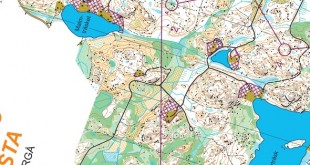
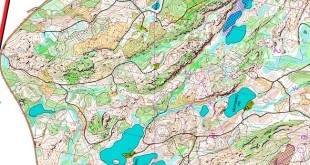
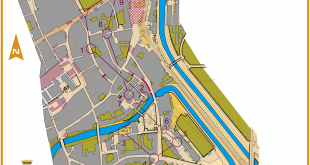
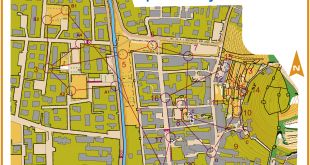
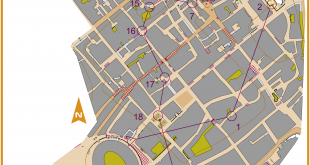
Thanks for interesting article! I agree that I have not seen a spreading principle yet which works well enough to make mass start interesting for TV. And you did not even touch the matter about all the TV cameras you would need to cover a mass start. However, I liked the idea with sections with score-o. You should have a way to show on TV what each runner has chosen before entering each score-o region though – that way the viewer will know more than the runners, which is always good for the viewer. Would love to see this developed further and tested.
I’d really like to get it tested. Will see if I can manage to get a simpler variant of it up in one of the local races here.
Please make sure that the “WOC in the future” peolpe in the orienteering federation read this!
I already know that some have:) And their thoughts are not that far from mine, as far as I could understand. To me it sounds like a chasing start is much for probable than a mass start for the future WOC program as of now.
Thank You Jan for a thourough and enlighted article. I very much agree with your conclusions and more than anything I fear that we’ll see an untested and consequently unsuccessful event at WOC.
Regarding the analysis I wish to add my two points:
1. Broadcasters (I’ve talked to both public and private ones) aren’t interested in the “understadability” of the event but in the “decisive moments”. They want to be able to extract, predict and schedule the “decisive moments” to fit with their overall programming.
2. I still think a mass-start at foot-o WOC will be a completely different event from anything else, be it ski-o, a relay or Blodslitet. With the workds 25 best runners tightly packed and looking to be first to finish in the most important event of the year, it can only be boring. The runners are just too good!
Thanks for your comments. Yes, the decisive moments are surely important – that’s the ones we all are waiting for in front of the TV. However, it is important that it is easy to understand that this is a decisive moment – and why it is decisive. And that’s the problem with e.g. the three-winged butterfly.. But I’m sure you are with me on that:)
Regarding tight races: Probably yes. But as long as there is some spreading and tricky orienteering, people are bound to make errors under the immense pressure. Just take a look at some of the stupid mistakes done in the WOC relays the last year. I think that a chasing start based on a 25-30 minute prologue would increase this possibility further due to the spreading you’d get then.
I think that mass start wouldn’t be interesting, because there are about 20 strong runners and most important thing would be “who is the best finisher?” ….everything would be boring except finish -.-
We can see that normal start in orienteering is something like start in alpine skiing, but skiing is intresting, because people know the rules and something about competitors (who is the best?, etc.)…
It the courses where gaffled like in a relay (where you never know if you have the same control as the others), I’m sure it would be possible to make it very exciting. The problem is that then it would not be fair. There might still be possibilities to make a spreading method which gives some of these factors while still being fair (enough). The problem for the decision to be made this sprint/autumn is that it is too soon. My hope is that the Nordic Tour can be used to test this kind of concepts – I thought that was kind of the idea with the NORT. I really hope they manage!
The public already watch normally (high profile) intervalled races such as down-hill skiing and biathlon. They understand the format and as long as the best go last there is usually enough excitement…
Orienteering should focus on bringing the technology, some of which is already here, closer to the TV/Internet audience. GPS and cameras are a good start, would be great to add say head-cams – would be great to jump to the runner’s view of the forest just as they are making a mistake, at the same time as you see the tracking and map also on the split TV screen – maybe with some overlay graphic to the head-cam picture showing the viewer where the runner should go…
Orienteering should focus on bringing the technology, some of which is already here, closer to the TV/Internet audience.
I couldn’t agree more. At the same time, it is a fact that there is a decision on the table regarding changing the WOC program (and this is a result of votes from the IOF member countries). Thus I’d rather focus to make sure the changes made are the best for the sport, rather than arguing against it. Arguing against it won’t bring any good (I think) – finding the best among the possible alternatives can bring the sport forward.
Personally I am no big fan of either mass start nor chasing start, but I can see interesting possibilities with a chasing start (and actually also with a mass start) if hard work is done on developing the format appropriately. It won’t be like a hard core long distance orienteering race, but there is a good chance that it actually is closer to what the young people just starting orienteering want to run.
What one should not do, is to make a decision to change the WOC program to some untested format. Develop concepts, use training camps and the Nordic Orienteering Tour for testing – and if it works, then one can start discussing to include it in the World Champs…
“Do we currently have a way to make mass start interesting for spectators and TV viewers?”
I thought WOC was about seeing who the best orienteer in the world was, so surely the question should be ‘do we currently have a war to make mass start interesting for competitors?’
The IOF are making decisions about WOC which significantly affect the ethos of the event. Old men in suits should not be making decisions that none of the elite orienteers agree with…
@Mark: Actually it is the majority of the IOF member countries who are responsible for the decisions. The proposal for setting up a new WOC program was decided by the votes of the member countries.
Furthermore, before a new WOC program is decided for, all member countries will get the possibility to post their opinions about the suggestions.
Also, there are two athletes, Wingstedt and Rollins, representing the athletes in the WOC in the future group. Thus, I’d say these are not decisions made just by “old men in suits”. I think the process is not bad – however it is important to speak up with your opinion in the right forums. Through your federation will be a good way, for example.
Also, I think discussions like the ones I’ve gotten into while working with this article – and very interesting e-mails and phone calls afterwards, help to get all aspects on the table. Therefore I also welcome all constructive comments which can lead to interesting new insights.
The majority of IOF member countries is not the same thing as the majority of international athletes. The votes were cast by old men in suits from national federations, and then these were given to old men in suits at the IOF.
Wingstedt and Rollins are sprint orienteers who are about to retire. I’ve never heard once from Rollins, so I cannot say that she is fully representing athletes in GBR, let alone other countries.
How many athletes have actually had any say in the future of WOC decision? Very very few. How many athletes complained about WOC 2010 being designed purely for spectators and media, very very many.
Give up the olympic dream and keep orienteering as a forest sport.
If the IOF did a vote of every person who ran in WOC or World Cup, that would be fair. But the decisions are not being made by athletes.
I’ve never heard once from Rollins, so I cannot say that she is fully representing athletes in GBR, let alone other countries.
Ah – but my point is that you (the athletes) should talk to Rollins and the representatives from your federation (I’m sure you’ll meet most of them without suit at orienteering races?) to tell them what is right – I unfortunately wouldn’t expect them to contact all top athletes. I think talking to the people making the decisions is one of the best ways to influence the future or orienteering. Then you would get something to say in the future of WOC decision. It is still not too late though – as decision won’t be made until this autumn. If your reasoning is good enough, I’m sure they’ll listen…
In my country the delegates to the IOF are elected and instructed by the national board. There is no way somebody else then a member of the national board can influence the position of my federation. International politics are not discussed with the members of my federation. So maybe they are not ‘old men in suits’, but ‘pepole, who know what’s best for orienteering’ with little legitimation from the base. (see the poll above)
Look at crosscountry skiing were masstarts have been introduced instead off individiual starts. A total catastrophy. Totaly uninterseting in 99 percent of the time.
Actualy the long distance as it is today is probalbly the distance witch is best to make media friendly, and that without making any changes to the courses.
The sprint is to short and you get report from many controls at the same time. Hard to catch up if you are not a hardcore orienteerer.
The middle is ok but seldom has the routechiose options that we see at long.
The long: start the bradcast when the last runner have run afair bit. Then make a summery that catches up to live when the last 10-15 runners have 30 min left.
With splits and gps you can make it very interesting
Look at crosscountry skiing were masstarts have been introduced instead off individiual starts. A total catastrophy. Totaly uninterseting in 99 percent of the time.
I couldn’t agree more! Mass start kind of work in Tour de Ski due to the bonus seconds, but in other races it is not very interesting. On the other hand the bonus seconds seem to make the overall Tour less interesting as it leads to a more spread out field.
Actualy the long distance as it is today is probalbly the distance witch is best to make media friendly, and that without making any changes to the courses.
Yes, and as NRK was also satisfied with the long distance in Trondheim. It is therefore good to see that the WOC in the future work group has decided to keep the long distance as it is today.
The sprint is to short and you get report from many controls at the same time.
Also what NRK said after Trondheim.
The long: start the bradcast when the last runner have run afair bit. Then make a summery that catches up to live when the last 10-15 runners have 30 min left.
I’ve also always thought that this is a good idea. However, I’ve heard from TV people that making this kind of broadcasts (with summaries) is quite challenging. But I’m not sure if this is a real problem.
Yeah. Masstart is boring unless you add …
Knockout-Decisions! :-)
Example: http://o-zeugs.blogspot.com/2011/02/woc-2014-langdistanz-mit-massenstart.html
Let them run a system of butterflies, and every time a branch of the forking system resolves, kick out the second half of the runners (sprint decisions!!). Do this until you got the six best runners, then let them run a longer unforked loop against eachother.
What a thrill! ;-) One single mistake and you are out…
Similar ideas about Mass start with combinaton of some kind of score/goat race and Knockout system here
http://www.attackpoint.org/discussionthread.jsp/message_444070
It might be better if we ask first what would be the best format for a mass start race. Something fair, fun to run and fun to watch with GPS tracking. Figuring out new formats, old formats and trying them all at trainings. Then pick best ones for national races, then try best of those at national TV races. And if athletes and spectators love it, it would spread all over the world on it’s own. New idea/format will fly if format is a truly good one. And when that happens, then we might start discussing about WOC. So, if some people want to get mass start to WOC, they should start doing the home work and come up with a format both athletes and spectators get exited about.
This is also the way I’d prefer it to be done. I think this might be why micr-o never got accepted, as variants of the micr-o format are really interesting. If introduced from the bottom up instead of from the top down, I think there might have been potential for the format (of course in a way where all end up running the same course).
That said, there is now already a decision to evaluate the introduction of mass start (or even a decision to introduce mass start? But I guess it is still possible to change this decision by the WIF group), and thus there is a bit of a pressure to find methods which work just now…
Hi,
I think that as long as foot orienteering is free from the media and the profit making machine, it is clean and enjoyable.
But if orienteering adapts to the money making machine, it will be ruined forever, just like all the elite sports, which are abnormal and false.
Oh Yeah¡¡¡
I agree with you, more forest less TV
I have’nt read the whole discussion and article. But I think this example from Swedish Night champs is interesting. Mass-start, and then, first 3 courses where you run nearby other runners on other courses in the same class, and coming controls early in the race. And then, a new map on the spectator control, in the arena after each 10-15 minutes in the forest for the leader. And after all spreadings end a new last loop that everybody has, in a new area around the arena, where nobody has been before earlier in the race. You’ll get a winnertime around 45 minutes, which is pretty long for middle-distance. But keeping the individual middle distance, I think, is a good idea. Maybe a winner time around 30 minutes, there, is OK. This is maybe a good start for middle-mass-start, but it has to be developed.
With this you’ll get a great arena and a sheap and great TV-broadcasting.
But I dont belive in a fifth mass-start distance in world champs for ski-orienteering and MTB-O or other diciplines. They sometimes start together, so, let them.
Mass-start, and then, first 3 courses where you run nearby other runners on other courses in the same class, and coming controls early in the race.
This is a kind of forked loops spreading method. My problem with this kind of spreading is that you never know who is in the lead, as it is impossible to make all variants in exactly the same length. Thus you have a lot of “mystery time” – and it is not easy to see where the race is actually decided..
Oh, fast answer.
Maybe a control that everybody on all three small courses out in the forest, is a way to get spectators, even on the TV. This maybe not has to be on o bigger path to get spreading in the running. But maybe that is more fair. But the whole metod is’nt fair.
But anyway, maybe something like that, but it has to be developed.